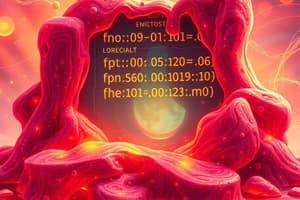Podcast
Questions and Answers
During the absorbing phase of sponge construction, how does the size of 'r' (bits) affect the number of permutation calls, assuming the message length remains constant?
During the absorbing phase of sponge construction, how does the size of 'r' (bits) affect the number of permutation calls, assuming the message length remains constant?
- Smaller 'r' results in fewer permutation calls.
- The number of permutation calls is directly proportional to 'r'.
- Larger 'r' results in fewer permutation calls. (correct)
- Larger 'r' results in more permutation calls.
If you know a message m and want to guess a tag t such that MAC_k(m) = t without knowing the key k, how does the length of the MAC tag in bits impact the probability of success?
If you know a message m and want to guess a tag t such that MAC_k(m) = t without knowing the key k, how does the length of the MAC tag in bits impact the probability of success?
- The probability decreases exponentially with the tag length. (correct)
- The probability increases exponentially with the tag length.
- The probability remains constant regardless of the tag length.
- The probability increases linearly with the tag length.
In the context of the Birthday Paradox, what is the primary objective when trying to find a collision regarding MAC (Message Authentication Code) values?
In the context of the Birthday Paradox, what is the primary objective when trying to find a collision regarding MAC (Message Authentication Code) values?
- Finding any two messages that produce the same MAC value. (correct)
- Finding a specific tag for a given message.
- Finding a message that produces a pre-determined MAC value.
- Finding a message with a MAC value equal to its hash.
According to the Birthday Paradox, how does the length of the MAC tag, denoted as t bits, influence the number of queries needed to find a collision?
According to the Birthday Paradox, how does the length of the MAC tag, denoted as t bits, influence the number of queries needed to find a collision?
Why is MD5 considered 'broken' in the context of cryptographic hash functions?
Why is MD5 considered 'broken' in the context of cryptographic hash functions?
What critical flaw led to SHA-1 being deemed insecure, similar to the issues found in MD5?
What critical flaw led to SHA-1 being deemed insecure, similar to the issues found in MD5?
What distinguishes the SHA-2 series from SHA-1 in terms of cryptographic design and security objectives?
What distinguishes the SHA-2 series from SHA-1 in terms of cryptographic design and security objectives?
What design feature of the Merkle-Damgård construction makes it susceptible to length-extension attacks?
What design feature of the Merkle-Damgård construction makes it susceptible to length-extension attacks?
How does the Davies-Meyer construction function in the context of creating a compression function for hash algorithms?
How does the Davies-Meyer construction function in the context of creating a compression function for hash algorithms?
What is the critical implication of a cryptographic hash function being collision-resistant regarding its ability to prevent second preimage attacks?
What is the critical implication of a cryptographic hash function being collision-resistant regarding its ability to prevent second preimage attacks?
In cryptographic terms, what does 'collision resistance' specifically ensure within a hashing algorithm?
In cryptographic terms, what does 'collision resistance' specifically ensure within a hashing algorithm?
How does 'second preimage resistance' in a cryptographic hash function differ fundamentally from 'collision resistance'?
How does 'second preimage resistance' in a cryptographic hash function differ fundamentally from 'collision resistance'?
If a full Merkle-Damgård hash function, denoted as h, is considered collision-resistant, what condition must be true of its compression function F?
If a full Merkle-Damgård hash function, denoted as h, is considered collision-resistant, what condition must be true of its compression function F?
What is the essential difference between a cryptographic 'primitive' and a 'construction' in the context of building larger cryptographic systems?
What is the essential difference between a cryptographic 'primitive' and a 'construction' in the context of building larger cryptographic systems?
Why is SHA-2 classified as a cryptographic 'primitive' despite being internally built using the Merkle-Damgård construction?
Why is SHA-2 classified as a cryptographic 'primitive' despite being internally built using the Merkle-Damgård construction?
According to the definitions provided, what is a Pseudorandom Permutation (PRP)?
According to the definitions provided, what is a Pseudorandom Permutation (PRP)?
What are the key characteristics that define PRP (Pseudorandom Permutation) security?
What are the key characteristics that define PRP (Pseudorandom Permutation) security?
When is it essential to utilize SPRP (Strong Pseudorandom Permutation) security instead of just PRP?
When is it essential to utilize SPRP (Strong Pseudorandom Permutation) security instead of just PRP?
Why does CBC-MAC (Cipher Block Chaining Message Authentication Code) directly necessitate access to decryption capabilities, as highlighted within the SPRP security model?
Why does CBC-MAC (Cipher Block Chaining Message Authentication Code) directly necessitate access to decryption capabilities, as highlighted within the SPRP security model?
In the context of sponge construction phases, how is the output generated during the squeezing phase if the required output length (n) exceeds the bit rate (r)?
In the context of sponge construction phases, how is the output generated during the squeezing phase if the required output length (n) exceeds the bit rate (r)?
How is the value of $1/2^{48}$ related to the probability of success?
How is the value of $1/2^{48}$ related to the probability of success?
Which characteristic makes Merkle–Damgård vulnerable to length-extension attacks?
Which characteristic makes Merkle–Damgård vulnerable to length-extension attacks?
What is the output size (digest) of the SHA-1 hash function?
What is the output size (digest) of the SHA-1 hash function?
What is the primary purpose of the Merkle-Damgård iteration mode in hash function design?
What is the primary purpose of the Merkle-Damgård iteration mode in hash function design?
What is the formula that describes the Davies-Meyer construction?
What is the formula that describes the Davies-Meyer construction?
The number of hash functions included in SHA-2 series is...
The number of hash functions included in SHA-2 series is...
Given an input x, which of the following statements best describes second preimage resistance?
Given an input x, which of the following statements best describes second preimage resistance?
CBC-MAC requires....
CBC-MAC requires....
What is the digest size of MD5?
What is the digest size of MD5?
Flashcards
Absorbing phase in sponge construction
Absorbing phase in sponge construction
The input message is processed in blocks of r bits; each block undergoes a permutation once.
Squeezing phase in sponge construction
Squeezing phase in sponge construction
Output generated in r-bit chunks, applying the permutation for each needed output exceeding r.
Blind Tag Guessing
Blind Tag Guessing
Guessing a message's tag without knowing the key, but not looking for a collision, aiming only to guess the correct tag for a given message.
Birthday Paradox in MACs
Birthday Paradox in MACs
Signup and view all the flashcards
MD5
MD5
Signup and view all the flashcards
SHA-1
SHA-1
Signup and view all the flashcards
SHA-2 Series
SHA-2 Series
Signup and view all the flashcards
Merkle-Damgård iteration mode
Merkle-Damgård iteration mode
Signup and view all the flashcards
Compression function F
Compression function F
Signup and view all the flashcards
Davies-Meyer Construction
Davies-Meyer Construction
Signup and view all the flashcards
Collision Resistance
Collision Resistance
Signup and view all the flashcards
Second Preimage Resistance
Second Preimage Resistance
Signup and view all the flashcards
Why collision resistance doesn't imply second preimage resistance
Why collision resistance doesn't imply second preimage resistance
Signup and view all the flashcards
Primitive
Primitive
Signup and view all the flashcards
Construction
Construction
Signup and view all the flashcards
SHA-2 as a primitive
SHA-2 as a primitive
Signup and view all the flashcards
Pseudorandom Permutation (PRP)
Pseudorandom Permutation (PRP)
Signup and view all the flashcards
Strong PRP(SPRP) security
Strong PRP(SPRP) security
Signup and view all the flashcards
Study Notes
- Sponge construction phases:
- Absorbing phase: Input message absorbed in blocks of r bits, permutation applied to each block once, and the number of permutation calls is ceil(message_length / r).
- Squeezing phase: Output generated r bits at a time by applying the permutation, but only if more output is needed (n > r).
- In sponge construction, r determines performance, where larger r means few permutation calls.
- Blind tag guessing:
- You have a message m and want to guess tag t such that MACK(m) = t, without knowing the key K, and you want to avoid collisions, so you only hope to guess the correct tag for a given m.
- If the MAC tag is t bits long (e.g., 48 bits), then the success probability per guess is 1/2^t (e.g. 1/2^48).
- The security strength is t bits, not t/2.
- Birthday Paradox:
- It applies when trying to find any two messages m1, m2 such that MACK(m1) = MACK(m2) (collision).
- Not targeting a specific tag, just looking for any two that match.
- The number of queries until a collision is approximately 2^(t/2), leading to a security strength of t/2 bits.
- MD5 (Ron Rivest, 1991):
- Designed by Ron Rivest, one of the inventors of RSA, based on MD4, Produces a 128-bit digest.
- It is known to be broken (collision attacks exist, not secure anymore).
- SHA-1 (NIST, 1995):
- Inspired by MD5, but designed by the NSA, and it follows SHA-0, an earlier version.
- Produces a 160-bit digest, and is no longer considered secure.
- SHA-2 Series (NIST, 2001 and 2008):
- Reinforced versions of SHA-1 designed to resist known attacks, and includes 6 hash functions
- Output lengths vary from 224 to 512 bits.
- It is currently considered secure, but SHA-3 is now recommended for future-proofing.
- Internals of MD5, SHA-1 and SHA-2:
- All use Merkle-Damgård iteration mode, which builds a variable-length hash function from a fixed-size compression function, by splitting the message into blocks and processing them sequentially.
- Use compression function (F).
- In SHA-1 and SHA-2, F is based on a block cipher-like structure using Davies-Meyer mode.
- Davies-Meyer construction turns a block cipher into a compression function: F(h,m) = E_m(h) XOR h, where E_m(h) is the block cipher encryption of h using m as the key.
- Do MD5, SHA-1, and SHA-2 all use Merkle–Damgård?
- Yes, and all three families follow the Merkle-Damgård paradigm making them vulnerable to length-extension attacks.
- Hash Algorithm Summary
- MD5: 128 bits, uses Merkle-Damgård, Broken.
- SHA-1: 160 bits, uses Merkle-Damgård, Broken.
- SHA-2: 224-512 bits, uses Merkle-Damgård, secure (as of now).
- Collision resistance does not necessarily imply second preimage resistance.
- Definitions:
- Collision resistance: It is hard to find any two inputs x != x' such that h(x) = h(x').
- Second preimage resistance: Given a specific input x, it is hard to find a different input x != x such that h(x) = h(x').
- Collision resistance is about finding any two messages that collide – you get to choose both freely.
- Second preimage resistance is about being given a specific message initially, and then trying to find a second one that collides with it.
- Implication Hierarchy: Strongest to Weakest
- Preimage resistance
- Second preimage resistance
- Collision resistance
- Collision resistance does not imply second preimage resistance, but second preimage resistance does imply collision resistance.
- Security guarantee of the Merkle–Damgård construction: If the compression function F is collision-resistant, then the full Merkle–Damgård hash function h is also collision-resistant.
- What's the difference between a primitive and a construction?
- Primitive = a basic cryptographic building block, designed to be used by other constructions.
- Construction = a method or recipe that builds something bigger (like a hash function, MAC, stream cipher, etc.) from primitives.
- SHA-2 Primitive:
- Although SHA-2 (like SHA-256 or SHA-512) is built internally using a construction, from a higher-level perspective, SHA-2 is a hash function that is already packaged and ready to use.
- Internally, SHA-2 uses constructions - but as a whole, it's a standardized hash function primitive used in protocols, applications, digital signatures, etc.
- SHA-2 is a primitive, meaning:
- It is used directly in real-world protocols like TLS, Bitcoin, HMAC, etc.
- It takes variable-length input and produces a fixed-length digest.
- You don't "build" SHA-2 yourself (you use it as-is, as a black-box function with known security properties).
- When you build a hash function using the Merkle-Damgård construction, you are composing a new function from:
- A compression function F
- Padding
- Iteration logic
- Merkle–Damgård construction is more like a recipe to make something, while SHA-2 is the store-bought product.
- "PRP (Pseudorandom Permutation Security)":
- A pseudorandom permutation (PRP) is a function that is computationally indistinguishable from a truly random permutation when given only forward queries.
- A block cipher E:{0,1}^k x {0,1}^n -> {0,1}^n is PRP if, for any efficient adversary, distinguishing between Ek(.) (where k is a secret key) and a random permutation is computationally infeasible.
- The adversary has access to the encryption function Ek(x) (forward direction).
- PRP security does not require that the adversary is given access to the inverse function Ek^-1(y).
- PRP security does not require that the adversary is given access to the inverse.
- PRP example: Counter (CTR) mode and Output Feedback mode (stream modes).
- Secure PRP (SPRP) Security:
- A strong SPRP extends PRP by requiring that the function is indistinguishable from a random permutation, only if the adversary os given access to both encryption and decryption funcions.
- A block definition E:{0,1}^k x {0,1}^n -> {0,1}^n is SPRP, if for any efficient adversary with access to both Ek(.), Ek^-1(.), distinguishing it from a truly random permutation is computationally infeasible.
- When the inverse function (decryption) is used, which is common in MACs and some modes, SPRP security is needed.
- CBC MAC requires access to decryption.
- CMC, EMAC
Studying That Suits You
Use AI to generate personalized quizzes and flashcards to suit your learning preferences.




